Foot problems: a visual guide
Your feet take the weight of your whole body so it's easy to understand how a problem can quickly lead to discomfort.
Use this visual guide to learn more about common foot problems and how to treat and avoid them.
Visit the visual guide to foot problems on NHS Choices.Bunions

A bunion is a bony swelling at the base of the big toe and often leads to the big toe pointing inwards, towards the other toes.
A bunion develops as a result of the small bones in the toes (the phalanges) moving out of line with the longer bones that run through the foot towards the ankle (the metatarsals). Bunions are common and anyone can develop them, although they are more common in women.
The progression of a bunion may be slowed through the use of wider-fitting shoes or insoles and the pain can be easily managed by using painkillers. The only permanent solution is surgery, which may be recommended if your bunion causes you problems.
More on bunionsCorns and calluses
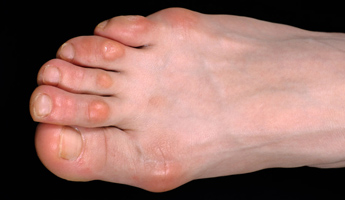
Corns and calluses are areas of hard skin on the feet caused by excessive pressure or shoes rubbing.
Corns are usually small and circular. Hard corns tend to develop on the bumpiest parts of the foot and soft corns develop between the toes where sweat keeps them moist. Calluses are wider and less well-defined and will often develop on the parts of the foot that take the most weight, such as the ball of the foot.
If they cause discomfort, corns and calluses can be treated by a podiatrist, who can cut away thickened skin. Choosing insoles or more comfortable shoes may also help.
More on corns and callusesVerrucas
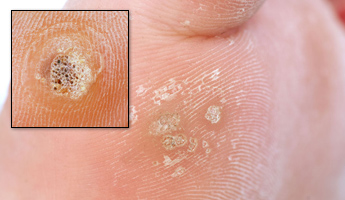
Verrucas are warts on the soles of the feet – often found on the heel or ball of the foot. They are caused by a virus (human papillomavirus) and range in size from approximately 1mm to 10mm. They can appear in pairs or groups and are flat, rough areas of skin – sometimes with a cluster of black dots at their centre.
Verrucas (like warts) are contagious but the risk of passing them on to others is low. The skin is most vulnerable when damaged, in contact with rough surfaces or if it's wet, for example in swimming pools and changing rooms. Verrucas are rarely painful and will often disappear without treatment within a year of appearing. Salicylic acid can speed up the process and is available from pharmacies.
More on verrucasIngrown toenail
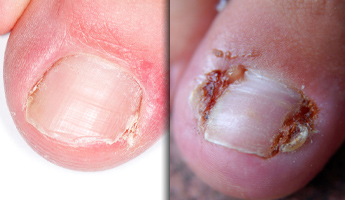
An ingrown toenail is a painful condition where the toenail grows into the skin at the side of the toe. The big toe is the most commonly affected, but any toe can develop an ingrown toenail. Ingrown toenails are mostly caused by ill-fitting or tight shoes, trimming toenails at an angle (toenails should always be cut straight across) and fungal nail infections.
An ingrown toenail will make the toe red, swollen and warm to touch. As it becomes more advanced, white or yellow pus may appear. Treatment will depend on how severe the problem is.
More on ingrown toenailAthlete's foot
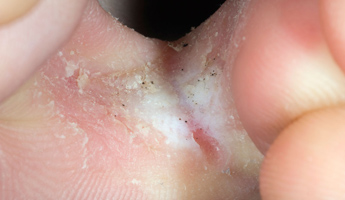
Athlete's foot is a skin infection caused by a fungus that likes the warm, damp and airless conditions that exist between the toes. Anyone can get athlete's foot and it is easily spread from person to person. This may happen in environments such as swimming pools or changing rooms.
Athlete's foot tends to start between the little toes and begins with an itchy rash that can spread if left untreated. The rash can cause the skin to become scaly, flaky, dry and red. It may lead to other symptoms such as blisters, swelling and stinging, or burning sensations in the skin. However, it is not a serious condition and can be treated with antifungal cream. Keeping toes clean and dry will help to prevent it reoccurring.
More on athlete's footFlat feet
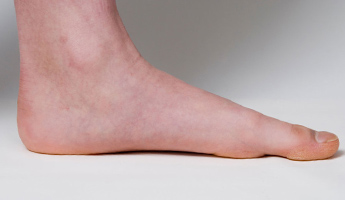
Most people have an arch, meaning the inner part of the sole of the foot is raised off the ground when standing. For people with flat feet, this part of the sole of the foot is flattened to the ground. This can run in families, but can also be caused by arthritis or a ruptured tendon.
Some people with flat feet may not experience any difficulties, but others may feel pain in the foot, ankle or leg. Wearing well-fitting shoes or insoles that support the arch of the foot can relieve discomfort. A podiatrist can help advise further on treatment.
More on flat feetHammer toes
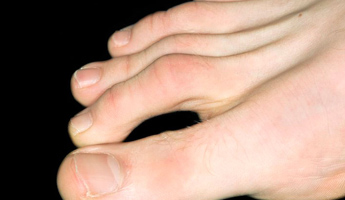
Hammer toe is a deformity of the second, third or fourth toe, when the toe appears permanently bent at the joint. There are a number of causes of hammer toe. Ill-fitting shoes are a common culprit. Injury, bunions or rheumatoid arthritis are other causes.
Hammer toe can cause other problems. Because the toe joint sticks out, it is more susceptible to shoes rubbing, meaning corns and calluses can develop. Hammer toes can also cause stress on the ball of the foot, which can lead to pain known as metatarsalgia.
More on metatarsalgiaUlcer (diabetic)
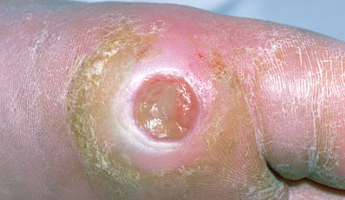
If diabetes is not correctly controlled, it can lead to nerve damage in the feet and legs called neuropathy. This means that people with diabetes are more likely to get foot ulcers as they have a reduced sensation of pain in their feet.
The slightest injury, such as blisters or cuts, can develop into an ulcer. Foot ulcers can be treated successfully if caught early, but if left untreated the consequences can be serious.
More on diabetic ulcerBlisters
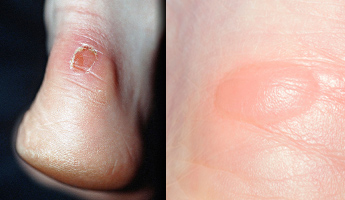
Blisters are very common and will most often develop as a result of friction (such as wearing ill-fitting shoes), contact with chemicals, heat (such as sunburn or a scald) and medical conditions such as chickenpox. A blister is a small pocket of fluid in the upper layers of the skin that often appears when the outer layer of skin has been damaged and acts to protect the tissue beneath.
Blisters will heal by themselves, but you should seek the advice of a doctor if a blister keeps coming back or becomes infected or painful.
More on blistersFungal nail infection
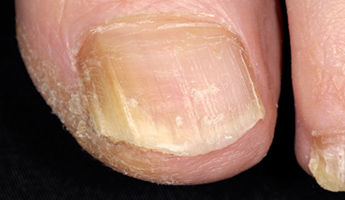
A fungal nail infection is four times more likely to develop in a toenail than a fingernail, and while it can look unsightly it is not serious and is rarely painful. A fungal infection can look ugly because the nail often becomes thickened and can turn white, black, yellow or green.
The nail can sometimes become brittle, with pieces of nail breaking off or even coming away from the toe completely. Underneath and around the nail (the nail bed), the skin can sometimes become inflamed and painful, but this tends to suggest a yeast infection. A fungal nail infection is not serious, but it will not clear up on its own and requires treatment with antifungal medicine.
More on fungal nail infectionChilblains

As the name suggests, chilblains develop as a response to cold. They often appear on your extremities – such as your nose, earlobes, fingers and toes – which tend to be more vulnerable to the cold. Chilblains tend to be very itchy and may be accompanied by a burning sensation.
Chilblains start as red lumps that can be painful and tender, and sometimes these lumps can blister. Chilblains will typically last about seven days and will heal on their own. However, if a blister or ulcer forms, there is a risk of infection. Some people will get chilblains each winter and should take extra care to keep their extremities as warm as possible.
More on chilblainsGout

Gout is a condition that causes painful swelling in the joints and is caused by a build up of uric acid in the blood. The body usually rids itself of uric acid when we pass urine, but if it builds up, crystals can form and collect in a joint, causing inflammation, swelling and pain.
The base of the toe is the most commonly affected joint and the pain can be severe, making walking very painful. The joint affected will normally swell and the surrounding skin may look red and inflamed. Gout is treated with medication and can be controlled through changes in diet and reducing alcohol consumption.
More on goutVisit the visual guide to foot problems on NHS Choices
NHS Choices 2014